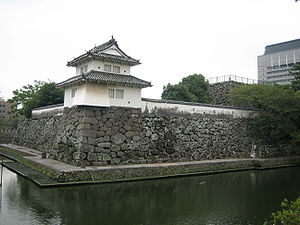
Funai Castle
Encyclopedia

Oita, Oita
is the capital city of Ōita Prefecture located on the island of Kyushu, Japan.- Demographics and geography :Ōita is the most populous city in Ōita Prefecture...
, Ōita Prefecture
Oita Prefecture
is a prefecture of Japan on Kyūshū Island. The prefectural capital is the city of Ōita.- History :Around the 6th century Kyushu consisted of four regions: Tsukushi-no-kuni 筑紫国, Hi-no-kuni 肥国, and Toyo no kuni...
, Japan
Japan
Japan is an island nation in East Asia. Located in the Pacific Ocean, it lies to the east of the Sea of Japan, China, North Korea, South Korea and Russia, stretching from the Sea of Okhotsk in the north to the East China Sea and Taiwan in the south...
. It was built by Otomo Sorin
Otomo Sorin
, also known as Fujiwara no Yoshishige and Ōtomo Yoshishige , was a Japanese feudal lord of the Ōtomo clan, one of the few to have converted to Christianity. The eldest son of Ōtomo Yoshiaki, he inherited the domain of Funai, on Kyūshū, Japan's southernmost main island, from his father...
in 1562, who owned much of the surrounding Kyūshū
Kyushu
is the third largest island of Japan and most southwesterly of its four main islands. Its alternate ancient names include , , and . The historical regional name is referred to Kyushu and its surrounding islands....
island. The castle was originally built with several turrets (yagura), all of which were burnt down with the three story donjon in 1743. The covered bridge that led to the castle over its moat, as well as several turrets, have been rebuilt in modern times. Original remains include part of the wall and the moat itself.

